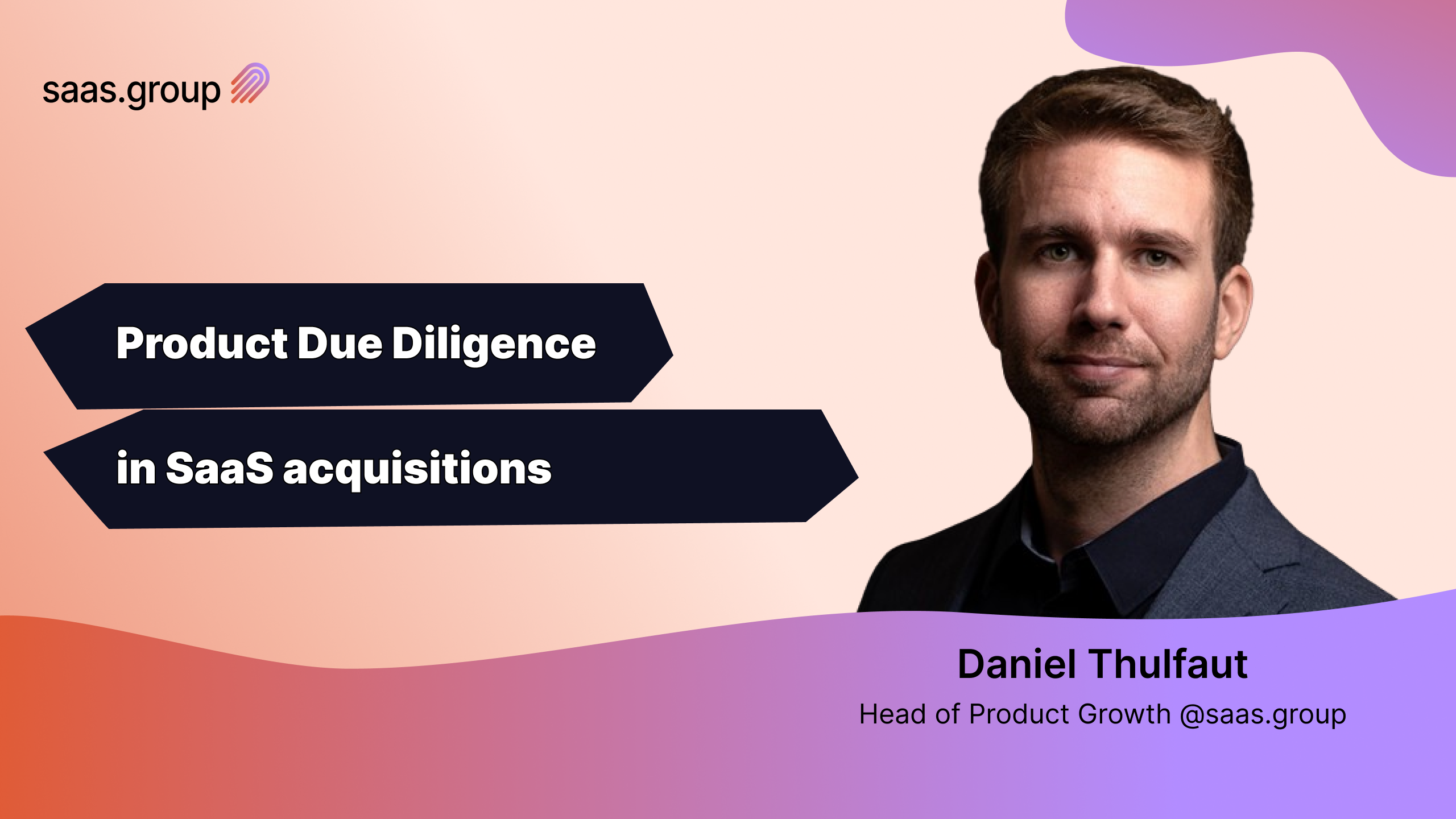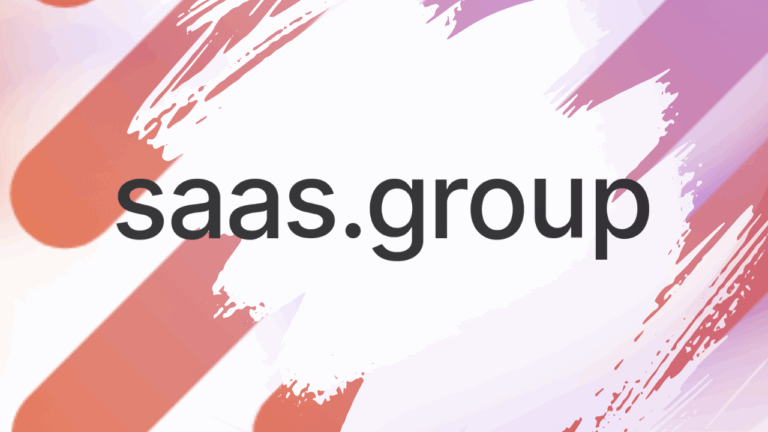At saas.group, the focus lies on acquiring promising SaaS companies and taking them towards greater success within a supportive and collaborative ecosystem.
But what does the process of acquisition look like? We talked with Daniel Thulfaut, Head of Product Growth at saas.group to shed some light on the nuances of product due diligence. With years of experience leading product teams and overseeing acquisitions of B2B SaaS businesses, Daniel walks us through the critical factors evaluated during acquisitions, and the strategies ensuring a seamless transition for acquired teams.
- What is product due diligence?
Product due diligence is our chance to vet a potential acquisition and make sure it fits into our family of brands and that we have the right resources to make it successful. During a DD we need to come up with hypotheses about potential quick wins, strategic pivots, and missing best practices that we can turn to. It also gives us a head start to expand the central team with the necessary resources, so we have all the support needed ready at the time of acquisition.
2. Are there any deal breakers on the product side of due diligence?
Very few, honestly. The level of product and product org maturity will eventually reflect in the acquisition price – which might mean becoming a financial deal breaker. From my perspective, real red flags are when the product itself does not fit into our existing portfolio at all and we don’t have the expertise to contribute. That is why we try to stay clear of B2C applications and hardware products, for example. We can do what we do because we have very specialized knowledge in the B2B SaaS space and can quickly impact these brands.
3. What’s the first thing you start evaluating when it comes to product due diligence?
The very first thing is to go through the product experience myself – especially the onboarding. This sometimes involves posing as a mystery shopper and going through the official sales cycle.
After decades of experience, we can pinpoint the major product issues, and most often even the history and development process behind them, just by using the product with fresh eyes from a user’s perspective. Interestingly, onboarding is also mostly the first thing we push to work with after the acquisition, with the highest potential to fix both conversion rate and churn issues.
4. How does the product team get involved after the acquisition? Do you start by making some drastic changes?
We usually try to avoid pushing changes very aggressively. During a DD we don’t have access to the full team. I believe a DD gives us a hypothesis to improve a business and a product. But we still owe it to the team to hear them out, view it from their perspective, and understand all the nitty gritty details before suggesting specific changes.
That is why we repeat the DD process in more detail and include the brand team in it. While we can often put our finger deadeye into the biggest wound, there is still an ivory tower effect in place, and we don’t want to take away responsibility and ownership from the team. That said, there are certain best practices that we want to see lived by every brand. If those are not present, we bake those changes and a reasonable timeframe into the acquisition contract.
5. 2023 has been about profitability and efficiency. Can we cut costs on the product side? What are the best practices we use?
If we look at a typical acquisition suspect, most of the teams see a lack of critical resources like product design, product analytics, or sometimes even a product manager owning the product experience. We don’t recommend cheaping out on these roles. Luckily, we run a very efficient central organisation that can lend these resources part-time to the brands to achieve a pragmatic, cost-efficient working model.
The two things we mostly recommend are:
First, revamp the pricing model and increase prices. This is the biggest lever SaaS companies have and also the most underutilized.
For a longer-term effect, we propose to find a more focused approach to product development and even sunset some existing features and product parts. Removing already developed features might sound counterintuitive, but this reduces technical debt and UI clutter and frees up development resources to be spent on something more impactful.
6. What are the most important questions you ask during the dd process?
Essentially, we ask the same questions we regularly ask in our quarterly product reviews. What have you recently shipped, and how did you decide if it was a success? What are you planning for the next cycle, and why are those the obvious roadmap items given the strategic analysis and product vision? In a DD, we dig a little deeper and let the brand walk us through the full process, from idea to release, and also explain the pricing model and the “data science” behind to us.
7. Do you evaluate the product team skillset during the dd?
Absolutely we do! But unfortunately, for the most part, it will be an educated guess based on results and performance since we don’t have direct access to the team. If for example, we find a very incoherent user interface with a clear lack of love for micro-interactions and guiding users, we can assume that the product designer on the team is rather junior (or nonexistent) or that the product org is not set up to include product design in the right touch points to allow for a better experience. Besides those giveaways, we also look at CVs and profiles on LinkedIn and ratios of PMs to developers and designers.
8. What would you recommend to the founders for an easier transition after the acquisition, product-wise?
The real magic happens when founders and acquired teams are open to suggestions and really want to use joining saas.group as a way to take their product to the next level. We have central teams with decades of experience in their fields and facilitated communities of practices to learn from each other. We have a genuine interest in seeing our brands flourish and be a part of their journey into the future. Very few startups and companies actually have access to that kind of talent and knowledge pool – embrace it and welcome us as your extended team and workbench!
Product due diligence in SaaS acquisitions identifies growth opportunities, and ensures compatibility and seamless integration for acquired teams at saas.group. By leveraging central resources and expertise, founders and acquired teams can navigate the transition seamlessly while focusing on efficiency and profitability. Ultimately, product due diligence not only assesses potential but also establishes a successful partnership and growth within saas.group‘s ecosystem.
If our values speak to you and resonate with how you do business, get in touch. Discuss your options with our M&A team: Dirk ([email protected]) or Pavel ([email protected]). Learn more about how we grow acquired brands on our blog and podcast pages.
Table of Contents
Weekly newsletter
No spam. Just the latest news and articles from the world of SaaS and Acquisitions.




